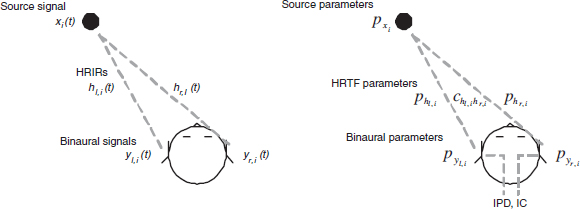8.3 Binaural parameter analysis
8.3.1 Binaural parameters for a single sound source
In conventional binaural rendering systems, a sound source i with associated time-domain signal xi(t) is rendered at a certain position by convolving the signal with a pair of headrelated impulse responses hl,i(t), hr,i(t), for the left and right ears, respectively, to result in binaural signals yl,i(t), yr,i(t):

with v ∈ {l, r}. This process is visualized in the left panel of Figure 8.1.
It is often convenient to express the convolution in the frequency domain using a frequency-domain representation Xi(f) of a short segment of xi(t):
![]()
with Hl,i(f), Hr,i(f) the frequency-domain representations (head-related transfer functions) of hl,i(t), hr,i(t), respectively. The power pyv,i at the eardrum resulting from signal yv,i in frequency band b is given by:

Figure 8.1 Synthesis of a virtual sound source by means of HRIR convolution (left panel) and by means of parametric representations (right panel). Reproduced from Breebaart, J. (2007). Analysis and synthesis of binaural parameters for efficient 3D audio rendering in MPEG Surround. IEEE Int. Conf. on Multimedia and Expo (ICME 2007), Beijing, China. Copyright ...
Get Spatial Audio Processing: MPEG Surround and Other Applications now with the O’Reilly learning platform.
O’Reilly members experience books, live events, courses curated by job role, and more from O’Reilly and nearly 200 top publishers.

